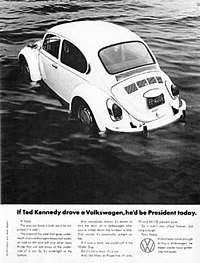Chappaquiddick incident
The neutrality of this article is disputed. |

The Chappaquiddick Incident refers to the circumstances surrounding the 1969 death of Mary Jo Kopechne, a campaign worker for U.S. Senator Edward M. Kennedy of Massachusetts. Kopechne was killed when the Senator became disoriented and drove his vehicle off of a bridge and into a channel after a party at Martha's Vineyard. The incident became a national scandal and may have affected the Senator's decision not to run for President in 1972.
Incident and initial response
On July 18, 1969, Ted Kennedy attended a party on Chappaquiddick, Martha's Vineyard, which was intended to be a reunion of those who had worked on his brother Robert's 1968 presidential campaign. Kennedy drove away with party guest Mary Jo Kopechne as a passenger in his 1967 Oldsmobile Delmont 88. According to Kennedy, he made a wrong turn onto an unlit road that led to Dike Bridge (also spelled Dyke Bridge), a wooden bridge angled obliquely to the road with no guardrail, and drove over its side. The car plunged into tide-swept Poucha Pond (at that location a channel) and came to rest upside down underwater. Kennedy was able to swim free of the vehicle, but Kopechne was not. Kennedy claims he tried to swim down to reach her several times, then rested on the bank for several minutes before returning on foot to the Lawrence Cottage, where the party attended by Kopechne and other "Boiler Room Girls" had occurred.
Joseph Gargan (Kennedy's cousin) and party co-host Paul Markham then returned to the pond with Kennedy to try to rescue Kopechne. Although there was a telephone at the Lawrence Cottage, nobody called for help. When their efforts to rescue Kopechne failed, Kennedy decided to return to his hotel. However, the Edgartown-Chappaquiddick ferry (which connects Chappaquiddick to the rest of the island) had shut down for the night. Kennedy swam across the 500-foot channel, back to Edgartown.
The next morning, the police recovered Kennedy's car and the body of Mary Jo Kopechne. Kennedy discussed the accident with several people, including his lawyer and Kopechne's parents, before discussing it with the police the next morning. Her death was ruled an accidental drowning, and no autopsy was performed.
Exhumation and inquest
District Attorney Edmund Dinis filed for and was granted a hearing on his petition for the exhumation of Kopechne’s body based on his testimony before a Pennsylvania court that blood was found on Kopechne’s skirt and in her mouth and nose. Prior to Dinis' claim, there was no mention of the presence of blood on the body or clothing of Kopechne. The reported discovery was made when her clothes were turned over to authorities by the funeral director.[1] Dinis alleged foul play, howevever there was little evidence to corroborate such a claim.
Resolution and impact
Kennedy entered a plea of guilty to a charge of leaving the scene of an accident after causing injury. He received a sentence of two months in jail, which was suspended. The sentence was notable in that the statute for the crime provided only for mandatory jail time and not the discretion of a suspended sentence. An Edgartown grand jury later reopened the investigation but did not return an indictment.
The incident quickly became a scandal. Kennedy was criticized for allegedly driving drunk, for failing to save Kopechne, for failing to summon help immediately, and for contacting not the police but rather his lawyer first.
Significance and legacy

It is widely believed that the Chappaquiddick incident was the major factor in Kennedy's decision not to run for president in 1972. The case resulted in much satire directed against Kennedy, including a National Lampoon page showing a floating Volkswagen Beetle with the remark that Kennedy would have been elected President had he been driving a Beetle that night; this satire resulted in legal action by Volkswagen complaining of unauthorized use of its trademark. [1]
Further reading
- Olsen, Jack (1970). The Bridge at Chappaquiddick. Little, Brown and Co. ISBN 9780441079582.
References
- "Dinis Says Blood On Mary Jo's Body", Boston Herald Traveler, September 16, 1969
- Jones, Richard E. "The Chappaquiddick Inquest: The Complete Transcript of the Inquest into the Death of Mary Jo Kopechne" (1979)
- "Lampoon's Surrender", TIME Magazine, November 12, 1973, retrieved September 10, 2006
See also
- ^ Boston Herald Traveler, September 19, 1969)
